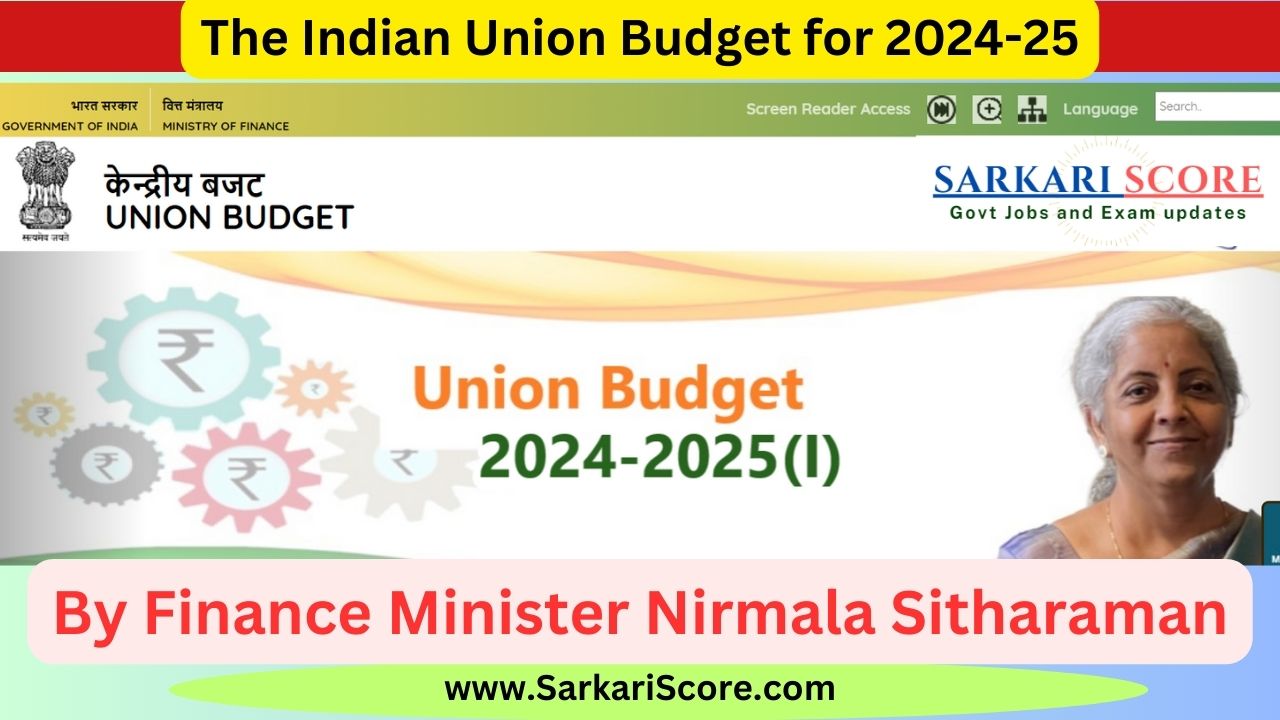The Indian Union Budget for 2024-25 is more than just a financial statement. It’s a blueprint for the nation’s economic strategy, outlining how the government plans to navigate the upcoming fiscal year. As the world grapples with economic uncertainty, this budget is crucial for setting the tone for India’s economic future.
The Presentation of the Budget 2024
Finance Minister Nirmala Sitharaman is expected to present the Union Budget 2024-25 on July 23rd, 2024. This date, though not officially confirmed yet, marks an important moment where the government’s economic priorities and plans for the next fiscal year will be laid out. Sitharaman’s presentation will be watched closely by analysts, businesses, and citizens alike. It serves as a guide for the country’s economic policy, detailing the steps the government will take in the next fiscal year.
Economic Context
The global economy faces several challenges, from geopolitical tensions to supply chain disruptions and inflationary pressures. India, while resilient, is not immune to these issues. The Budget 2024 must address these global headwinds while focusing on domestic economic stability and growth.
Budget 2024 Focus Areas
Economic Growth and Fiscal Responsibility
Balancing economic growth with fiscal responsibility is no small feat. The government aims to stimulate growth through increased spending on key sectors while maintaining fiscal discipline. This balancing act is crucial for sustainable development.
Infrastructure Development
Infrastructure remains a cornerstone of economic development. Investments in roads, railways, and ports not only improve connectivity but also create jobs. The Ministry of Road Transport and Highways is likely to see significant allocations to bolster infrastructure projects across the country.
Manufacturing and Exports
To boost manufacturing and exports, the budget may introduce incentives for sectors that drive economic growth. These initiatives are essential for making India a global manufacturing hub and increasing its export capacity.
Social Welfare and Inclusive Development
Pradhan Mantri Awas Yojana (PMAY)
The Pradhan Mantri Awas Yojana (PMAY) has been a flagship scheme for providing affordable housing. With an additional target of 2 crore houses under PMAY (Gramin) in the next five years, the budget is expected to allocate substantial funds to ensure the success of this initiative.
“Lakhpati Didi” Program
Empowering women entrepreneurs is another priority. The “Lakhpati Didi” program aims to uplift women by providing them with entrepreneurial opportunities. This budget could expand the program to reach more beneficiaries, fostering inclusive growth.
Other Social Welfare Schemes
Social welfare programs targeting education, healthcare, and nutrition are vital for inclusive development. Expect increased funding and new initiatives to support these areas.
Infrastructure Initiatives
Ministry of Road Transport and Highways
Significant investments in the Ministry of Road Transport and Highways are anticipated. These funds will support major infrastructure projects that enhance connectivity and facilitate economic activities.
Key Infrastructure Projects
From highways to smart cities, key infrastructure projects will likely receive boosts in funding. These projects are essential for modernizing India’s infrastructure and supporting economic growth.
Fiscal Consolidation and Reforms
Fiscal Responsibility and Budget Management (FRBM) Act
Maintaining fiscal discipline under the FRBM Act is crucial. The government might explore measures to streamline tax administration and increase efficiency while ensuring compliance with fiscal targets.
Tax Administration Reforms
Reforming tax administration to reduce complexities and improve compliance is on the agenda. Simplifying tax processes can enhance transparency and boost revenue collection.
New Revenue Streams
Exploring new revenue streams, such as monetizing government assets and increasing digital economy contributions, could be part of the strategy to enhance fiscal health.
Investment in New India
Vision of “Amrit Kaal”
The budget might allocate funds towards initiatives aligned with “Amrit Kaal,” a vision for the next 25 years leading to India’s 100th year of independence. This vision focuses on long-term sustainable growth and development.
Clean Energy Investments
Investments in clean energy are crucial for achieving sustainability goals. Expect significant allocations towards renewable energy projects and initiatives to reduce carbon emissions.
Digital Infrastructure
Digital infrastructure is the backbone of a modern economy. The budget is likely to prioritize investments in digital infrastructure to support technological advancements and digital inclusion.
Workforce Skilling
Skilling the workforce is essential for economic growth. The budget might introduce new programs and enhance existing ones to equip the workforce with the skills needed for the future.
Key Budget Allocations
Education Sector
Allocations for the education sector will focus on improving access, quality, and infrastructure. Initiatives to promote digital learning and skill development might be prominent.
Healthcare Sector
The healthcare sector is expected to receive significant funding to improve infrastructure, accessibility, and quality of care. Pandemic preparedness and healthcare innovation could be key areas of focus.
Agriculture Sector
Supporting the agriculture sector is crucial for rural development and food security. The budget might introduce measures to enhance productivity, provide financial support to farmers, and promote sustainable farming practices.
Taxation Changes
Income Tax Slabs
Changes to income tax slabs and deductions are anticipated to provide relief to taxpayers and stimulate economic activity. Any modifications will be closely watched by individuals and businesses alike.
Deductions
Enhancing deductions and exemptions can provide financial relief and encourage investments in certain sectors. The budget might introduce new deductions or modify existing ones to achieve specific economic goals.
Indirect Taxes
Adjustments to indirect taxes, such as GST, can impact consumer prices and business operations. The budget might introduce changes to streamline the tax structure and improve compliance.
Employment Generation
Job Creation Measures
Creating jobs is a top priority. The budget might include measures to boost employment in sectors like manufacturing, infrastructure, and services. Support for startups and MSMEs can also drive job creation.
Support for Startups and MSMEs
Startups and MSMEs are vital for economic growth and innovation. The budget might introduce incentives, financial support, and regulatory reforms to foster the growth of these sectors.
Demographic-Specific Schemes
Youth-Targeted Initiatives
Initiatives targeting the youth, such as skill development programs, entrepreneurship support, and education enhancements, are crucial for harnessing the demographic dividend.
Farmer Support Programs
Supporting farmers through financial aid, subsidies, and development programs is essential for agricultural growth and rural development. The budget might introduce new schemes to address farmers’ needs.
Women Entrepreneur Programs
Empowering women entrepreneurs through financial support, training, and mentorship can drive inclusive growth. The budget might expand existing programs and introduce new initiatives to support women in business.
Anticipated Challenges
Balancing Growth and Fiscal Prudence
One of the main challenges will be balancing the need for economic growth with fiscal prudence. Ensuring that increased spending does not lead to excessive fiscal deficits is crucial.
Managing Inflation
Inflation management is another critical challenge. The budget must introduce measures to control inflation while stimulating economic activity.
Global Economic Uncertainties
Navigating global economic uncertainties, such as trade tensions and geopolitical risks, is essential for maintaining economic stability. The budget must be flexible enough to adapt to these challenges.
Union Budget 2024
The Union Budget 2024 is set to be a pivotal one, shaping India’s economic trajectory for years to come. With a focus on growth, social welfare, and long-term vision, it aims to pave the way for a more inclusive and prosperous India. By closely examining the budget document and following announcements by the Finance Minister, we can gain a deeper understanding of the government’s plans and their potential impact on the nation’s future.
FAQs
1. What is the Indian Union Budget 2024-25?
The Indian Union Budget 2024-25 is a financial statement presented by the government, outlining its plans for revenue and expenditure for the fiscal year starting April 1, 2024.
2. When will the budget be presented?
The budget is expected to be presented on July 23rd, 2024, although this date is yet to be officially confirmed.
3. What are the main focus areas of the budget?
The main focus areas include economic growth, infrastructure development, social welfare, fiscal consolidation, and investments in clean energy and digital infrastructure.
4. How will the budget impact social welfare programs?
The budget is likely to increase funding for social welfare programs, such as affordable housing, women’s empowerment initiatives, and education and healthcare improvements.
5. What are the expected changes in taxation?
Changes in income tax slabs, deductions, and indirect taxes like GST are anticipated, aiming to provide relief to taxpayers and stimulate economic activity.


